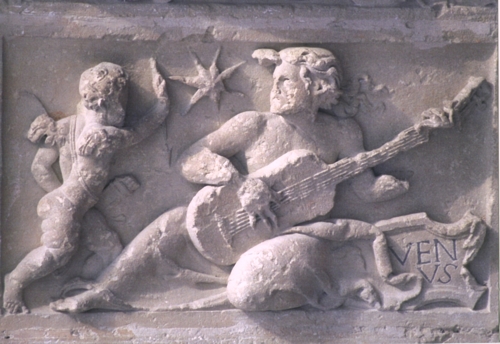Venus playing the vihuela
(1541-1544) - Úbeda (Jaén), Iglesia de San Salvador
instrument: vihuela de mano | century: 16cent/2/mid | catalogue nº: 16-218

Artwork
Creator Chamet, Etienne
Medium Artwork: Sculpture
Location
City Ubeda (Jaén) | Region Andalucia | Old kingdom Castile
Characteristics
| Body Waisted | Strings 6 strings | Neck Long | Pegbox R/Angled channels |
| Bridge Fixed | Frets No | Back Not visible | Pegs Lateral |
| Technique Plucked fingers thumb out |
Commentary
ARTWORK
Bas-relief, by Etienne Chamet (b. ca 1515) known in Spain as Esteban Jamete or Chamete, on the main portal of the Iglesia de San Salvador, in Úbeda, (Jaén). This is the church commissioned by the Comendador Mayor de León, Francisco de los Cobos, the dedicatee of the vihuela book Los seys libros del Delphin by Luis de Narváez, and his presumed patron. The chapel was built by Diego de Siloé, commencing in 1536. It was consecrated in 1559, although work was no completed until later in the century. The bas relief sculptures were realised by Etienne Chamet between 1541 and 1544. The sculpture of the goddess Venus accompanied by Cupid playing the vihuela is one of the eleven images of gods that adorn the portal. The number of depictions of female players is not large, and this one contrasts with the more usual depictions of Orpheus, Apollo, etc. This sculpture has only become widely known since the publications of Gétreau and González. Previously, a photograph of the sculpture had reached Emilio Pujol, but it was only known and circulated among his colleagues and students.
INSTRUMENT
A well-represented seeming large vihuela, and its long neck that could easily be fretted with 12 frets. González observes, in relation to the size of the player, that this instrument could have a length of around 100cm, with a string length of approximately 80cm, thus similar to the Guadalupe instrument in Musée Jacquemart-André in Paris (16-124). It has a narrow neck, with six courses clearly depicted, but each carved as a single course. The soundbox is long, semicircular at the lower bout. The back is probably flat. The bridge is positioned about 1/6 of the length of the body, from the bottom. The rosette is located quite high, aslmost at the widest point of the upper bouts. The peg box is inclined backwards, channelled and with lateral pegs.
Reproductions
https://commons.wikimedia.org/wiki/File:Venus_vihuelista_de_Úbeda_(Jaén).jpg